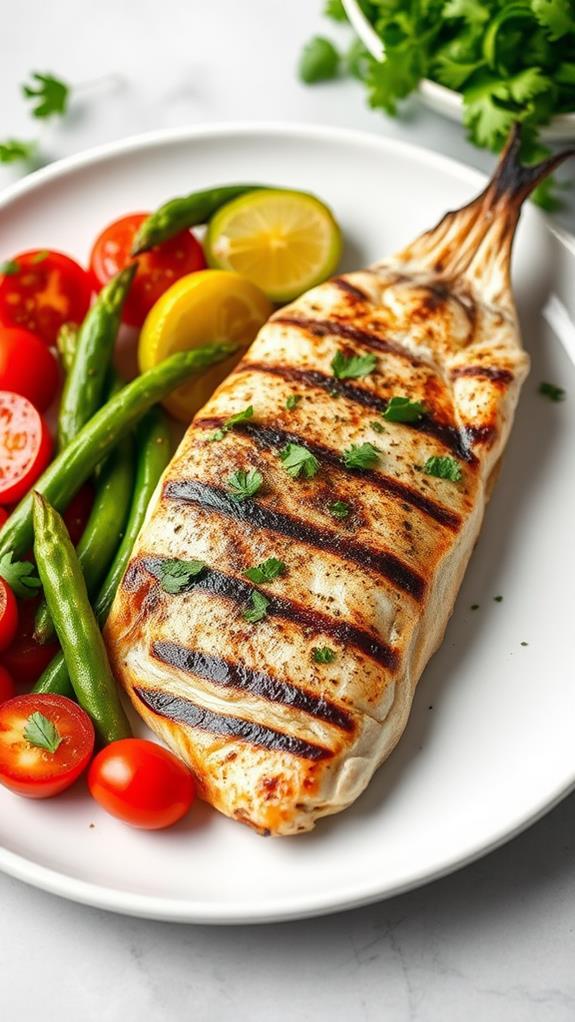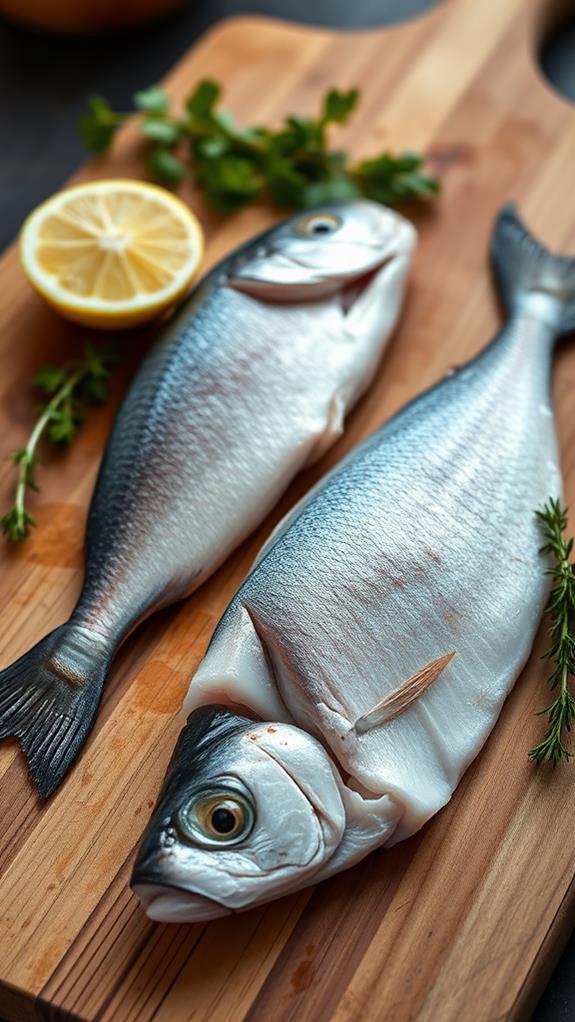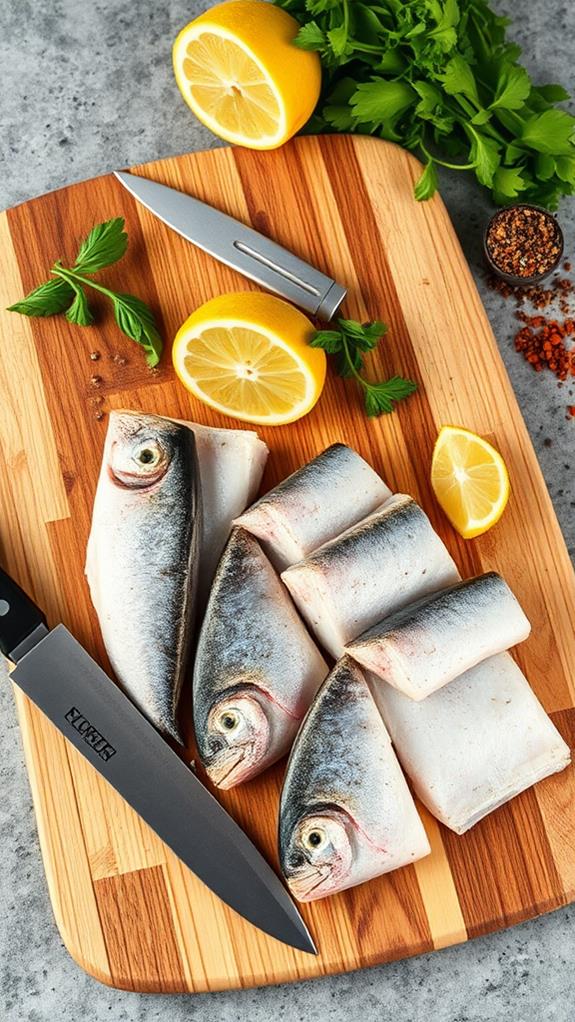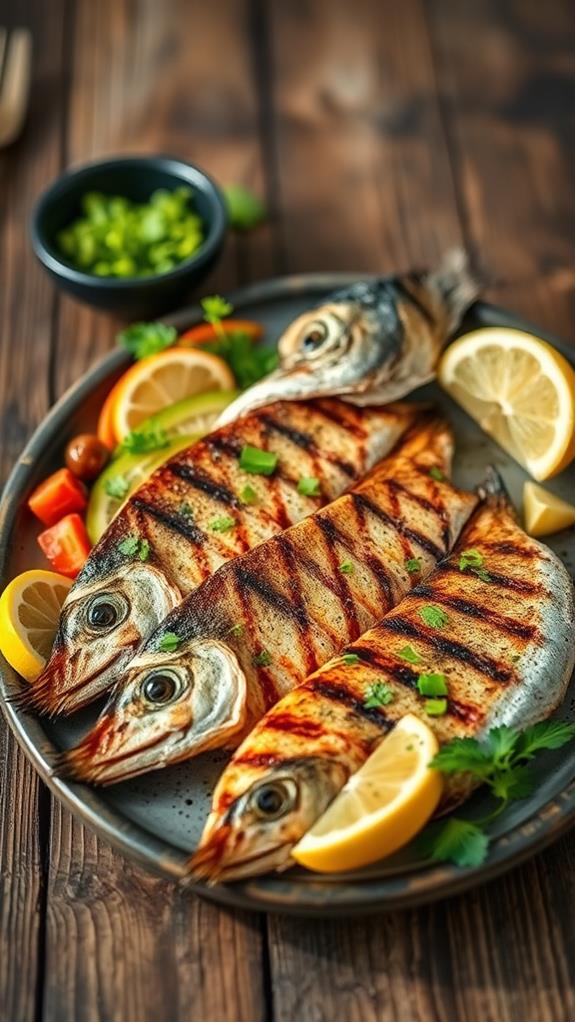Is Barracuda Safe to Eat
Barracuda can be safe to eat, but it comes with risks you should consider. While it's a lean protein source rich in nutrients like vitamin B12 and selenium, barracuda can accumulate ciguatoxins, which cause ciguatera poisoning. This risk increases with the fish's size, so it's safer to consume smaller barracuda (less than 3.5 feet long). Proper preparation is essential: remove the skin, bloodline, and internal organs, and cook thoroughly. Be aware that barracuda can also contain high levels of mercury, making it potentially harmful for pregnant women and young children. Local regulations and guidelines can provide valuable information about safe consumption in your area. Understanding these factors will help you make an informed decision about including barracuda in your diet.
This post may contain affiliate links. If you make a purchase through these links, I may earn a commission at no additional cost to you. Additionally, portions of this post may be generated using artificial intelligence (AI) technology. While we strive for accuracy, please be aware that AI-generated content may not always be perfect and should be fact-checked when necessary.
The Spatula Scoops
- Barracuda can be safe to eat if properly prepared and sourced from reputable suppliers.
- Smaller barracuda (less than 3.5 feet) are generally safer due to lower toxin accumulation.
- There's a significant risk of ciguatera poisoning, especially from larger barracuda in tropical waters.
- Proper preparation techniques, including removing skin and bloodline, can reduce toxin concentration.
- Pregnant women and young children should limit or avoid barracuda due to potential mercury content.
Nutritional Profile of Barracuda

Regarding nutrition, barracuda offers a lean protein source with several essential vitamins and minerals. You'll find it's particularly rich in vitamin B12, which supports your nervous system and blood cell formation. Barracuda also contains significant amounts of selenium, an antioxidant that aids in thyroid function and immune system health. Similar to salmon, barracuda provides omega-3 fatty acids that are important for heart and brain health, though in lower amounts. The nutritional profile of barracuda can vary depending on environmental factors, much like the differences between wild and farmed salmon.
When you consume barracuda, you're getting a good dose of omega-3 fatty acids, which are key for heart and brain health. However, it's worth noting that the omega-3 content is lower than in some other fish species. The flesh is low in saturated fat and calories, making it a suitable option for those watching their weight or cholesterol levels.
Barracuda provides essential minerals like potassium, which helps regulate blood pressure, and phosphorus, necessary for bone health. You'll also find trace amounts of iron, zinc, and magnesium in this fish. While it's not the most nutrient-rich seafood option available, barracuda can be part of a balanced diet when consumed in moderation. Remember, though, that its nutritional profile can vary depending on the fish's size, age, and habitat.
Ciguatera Poisoning Risk
Despite its nutritional benefits, barracuda consumption comes with a significant risk: ciguatera poisoning. This foodborne illness occurs when you eat fish that have accumulated ciguatoxins from consuming smaller reef fish. You can't detect these toxins by smell, taste, or appearance, and they're not destroyed by cooking or freezing. Similar to oxtail, proper handling and storage of barracuda are essential to maintain food safety, although these practices alone cannot prevent ciguatera poisoning.
If you're considering eating barracuda, you should be aware of the symptoms of ciguatera poisoning. These can include nausea, vomiting, diarrhea, and abdominal pain within hours of consumption. Neurological symptoms like tingling sensations, temperature reversal (cold feels hot and vice versa), and muscle weakness may follow. In severe cases, cardiovascular problems can occur.
The risk of ciguatera poisoning increases with the size of the barracuda. Larger, older fish have had more time to accumulate toxins. To minimize your risk, it's advisable to avoid eating barracuda larger than 3.5 feet or weighing more than 20 pounds. Additionally, you should be cautious when consuming barracuda caught in tropical or subtropical waters, particularly in areas known for ciguatera outbreaks.
Size Matters

When it comes to barracuda, size is a crucial factor in determining safety for consumption. Generally, smaller barracuda are considered safer to eat than larger ones. This is because larger barracuda have had more time to accumulate toxins in their bodies, particularly ciguatoxins. Much like bears' feeding habits, barracuda's diet and size directly impact their safety for human consumption. Larger barracuda, similar to how bears consume massive amounts of food before hibernation, tend to accumulate more toxins over time.
You'll want to focus on barracuda that are less than 3.5 feet (1 meter) in length. These smaller fish are less likely to have high levels of ciguatoxins, making them a preferable choice for your plate. It bears mentioning that while size is a good indicator, it's not a guaranteed assurance of safety.
Local fishing regulations often reflect this size-safety correlation. In many areas, there are size limits on barracuda catches, with larger fish being off-limits. These rules are in place to protect both the fish population and human consumers. When you're purchasing barracuda, always inquire about its size and origin. If you're fishing yourself, use a fish measuring device to confirm you're within safe limits. Remember, while size matters, it's just one factor in the overall safety assessment of barracuda consumption.
Geographical Considerations
When considering barracuda consumption, you'll find that regional patterns vary appreciably. You're more likely to encounter barracuda dishes in coastal areas where the fish is readily available, while inland regions may have limited access to fresh barracuda. Local fishing regulations play an essential role in determining the availability and safety of barracuda consumption, so it's important to familiarize yourself with the rules in your area.
Regional Barracuda Consumption Patterns
Numerous regions around the world have distinct attitudes and practices when it comes to barracuda consumption. In the Caribbean, you'll find barracuda as a common menu item, often grilled or served in fish stews. However, locals are typically cautious about consuming larger specimens due to the increased risk of ciguatera poisoning.
Moving to the Mediterranean, barracuda isn't as prevalent in local cuisines. You're more likely to encounter it in coastal areas of Spain and Italy, where it's sometimes used in traditional dishes. In contrast, Pacific Island nations like Fiji and Samoa have a long history of barracuda consumption, with various preparation methods passed down through generations.
In the United States, attitudes vary by region. Florida residents are generally more familiar with barracuda as a food fish, while those on the West Coast might be less inclined to eat it. Asian countries like Japan and Korea have their own distinctive approaches, often incorporating barracuda into sushi or using it in dried form for soups and broths. Understanding these regional patterns is pivotal for content creators focusing on culinary topics, as it helps in crafting geographically relevant and SEO-optimized content.
Coastal vs. Inland Availability
The availability of barracuda for consumption varies dramatically between coastal and inland areas. If you live near the coast, you're more likely to find fresh barracuda in local markets and restaurants. Coastal regions often have direct access to fisheries and harbors, making it easier to source recently caught barracuda.
In contrast, if you're inland, your options for fresh barracuda may be limited. You'll typically find it frozen or processed in supermarkets, if available at all. The further you are from the coast, the more challenging and expensive it becomes to transport fresh barracuda while maintaining its quality.
This geographical disparity affects not only availability but also the culinary culture surrounding barracuda. Coastal communities often have traditional recipes and preparation methods for barracuda, while inland areas may be less familiar with the fish. Additionally, concerns about ciguatera poisoning, which is more prevalent in certain coastal regions, can impact consumption patterns. When considering barracuda consumption, it's important to factor in your location and the sourcing of the fish. Always verify you're purchasing from reputable suppliers, especially if you're far from the coast, to guarantee freshness and safety.
Local Fishing Regulations Impact
Local fishing regulations play a pivotal role in determining whether you can catch and consume barracuda. These rules vary widely depending on your location, so it's essential to familiarize yourself with the specific guidelines in your area. Many coastal regions have implemented size limits, bag limits, and seasonal restrictions to protect barracuda populations and ensure sustainable fishing practices.
You'll need to check with your local fisheries management agency or department of natural resources for up-to-date information. Some areas may require a fishing license, while others might have complete bans on barracuda fishing. It's worth noting that regulations can change based on scientific data and conservation efforts. For instance, Florida has implemented a slot limit, allowing you to keep barracuda between 15 and 36 inches, with a daily bag limit of two fish per person. In contrast, some Caribbean nations have stricter regulations due to concerns about ciguatera poisoning. Always research and comply with local rules to avoid fines and contribute to responsible fishing practices. Remember, these regulations are designed to maintain healthy fish populations and protect marine ecosystems for future generations.
Proper Preparation Techniques

When preparing barracuda for consumption, you'll need to focus on proper techniques to guarantee safety. Start by removing the skin and bloodline, as these parts can concentrate toxins. Next, choose cooking methods that thoroughly heat the fish, such as grilling or baking, to minimize the risk of foodborne illness. Finally, be sure to avoid any potentially contaminated parts of the fish, like the head, viscera, and roe, which are more likely to contain higher levels of toxins.
Removing Skin and Bloodline
Proper preparation of barracuda begins with removing its skin and bloodline, essential steps in ensuring the fish's safety for consumption. You'll need a sharp fillet knife and a clean cutting board to complete this process effectively. Start by making a shallow cut behind the gills and along the dorsal fin, then carefully peel off the skin, working from head to tail.
Next, focus on removing the bloodline, which is the dark red strip of flesh running along the length of the fillet. This area tends to concentrate toxins and can affect the taste. Here's what you need to do:
- Locate the dark red strip along the center of the fillet
- Make a V-shaped cut on either side of the bloodline
- Remove the bloodline completely, ensuring no red flesh remains
- Rinse the fillet thoroughly with cold water
- Pat dry with paper towels before further preparation
Cooking Methods for Safety
With proper cooking methods, you can further guarantee the safety of barracuda for consumption. Always verify that the fish is thoroughly cooked, reaching an internal temperature of at least 145°F (63°C). This temperature kills potential parasites and bacteria that may be present in the meat.
One effective method is grilling. Place the barracuda fillets on a preheated grill for about 4-5 minutes per side, depending on thickness. You'll know it's done when the flesh becomes opaque and flakes easily with a fork. Alternatively, you can bake barracuda in the oven. Preheat to 400°F (204°C), place the fillets in a baking dish, and cook for 15-20 minutes.
Pan-searing is another option. Heat oil in a skillet over medium-high heat, then cook the fillets for 3-4 minutes on each side until golden brown. For added safety, you can poach barracuda in simmering liquid for about 8-10 minutes.
Regardless of the method you choose, avoid consuming raw or undercooked barracuda. By following these cooking guidelines, you'll minimize the risk of ciguatera poisoning and verify a safe, enjoyable meal.
Avoiding Contaminated Parts
Carefully preparing barracuda is essential for avoiding potentially contaminated parts. When cleaning your catch, focus on removing the head, skin, and internal organs, as these areas typically contain the highest concentrations of ciguatoxins. It's imperative to fillet the fish properly, discarding any dark meat along the lateral line.
To ensure you're avoiding contaminated parts, follow these steps:
- Remove the head, which often contains the highest toxin levels
- Skin the fish completely, as toxins can accumulate in the skin
- Eviscerate the barracuda, disposing of all internal organs
- Trim away the dark meat along the lateral line
- Rinse the fillets thoroughly with clean water
Regulations and Guidelines
Governments and health organizations have established specific regulations and guidelines for consuming barracuda due to the potential risks associated with ciguatera poisoning. You'll find that these rules vary depending on your location, but they often include size restrictions and catch limits. In some areas, you're advised to avoid eating barracuda altogether, while in others, you're encouraged to consume only smaller specimens under a certain length.
It's essential that you check local advisories before consuming barracuda, as regulations can change based on recent data and environmental conditions. You'll often find these guidelines on government websites or through local fishing authorities. They might use terms like "bioaccumulation" or "trophic level" to explain why larger barracuda are more likely to contain higher levels of toxins.
When purchasing barracuda from markets or restaurants, you should inquire about their sourcing practices and adherence to local regulations. Remember, these guidelines aren't just bureaucratic red tape; they're designed to protect your health. By following them, you're reducing your risk of ciguatera poisoning and contributing to sustainable fishing practices.
Alternative Seafood Options

If you're hesitant about eating barracuda due to safety concerns, you've got plenty of other delicious and safer seafood options to choose from. These alternatives provide similar nutritional benefits without the risk of ciguatera poisoning. Consider incorporating these fish into your diet:
- Salmon
- Cod
- Tilapia
- Trout
- Halibut
These options are not only safer but also widely available and versatile in cooking. Salmon, rich in omega-3 fatty acids, offers excellent health benefits. Cod provides a mild flavor and flaky texture, perfect for various recipes. Tilapia is a lean, budget-friendly choice that's easy to prepare. Trout, with its delicate taste, is ideal for grilling or baking. Halibut, a firm white fish, is low in fat and high in protein.
When selecting seafood, look for sustainably sourced options to support ocean health. Check for certifications like the Marine Stewardship Council (MSC) label, which indicates responsible fishing practices. By choosing these alternatives, you'll enjoy delicious meals while minimizing health risks associated with barracuda consumption. Remember to vary your seafood choices to benefit from a range of nutrients and flavors.
Health Benefits and Concerns
Despite the potential risks, barracuda offers several health benefits when consumed safely. You'll find that it's an excellent source of lean protein, essential for muscle growth and repair. It's also rich in omega-3 fatty acids, which support heart health and reduce inflammation. Additionally, barracuda provides important minerals like selenium and potassium.
However, you should be aware of the concerns associated with eating barracuda. The primary issue is ciguatera poisoning, which occurs when you consume fish that have eaten toxic algae. Larger, older barracuda are more likely to carry this toxin. Symptoms can include gastrointestinal distress, neurological problems, and cardiovascular issues. There's no way to detect ciguatera in fish before consumption, making it a significant risk.
Another concern is mercury contamination. As a predatory fish, barracuda can accumulate high levels of mercury over time. Excessive mercury intake can lead to neurological problems and developmental issues in fetuses and young children. To minimize these risks, you should limit your consumption of barracuda, especially if you're pregnant or planning to become pregnant. Always source your fish from reputable suppliers and follow local advisories about fish consumption.
Frequently Asked Questions
How Does Barracuda Taste Compared to Other Popular Fish?
You'll find barracuda has a distinctive taste compared to other popular fish. It's often described as having a stronger, more pronounced flavor than milder options like cod or tilapia. The flesh is firm and slightly oily, with a taste that's often compared to mackerel or bluefish. Some find it slightly gamey or "fishy," while others appreciate its rich, full-bodied flavor. It's typically less delicate than popular white fish and can stand up to bolder seasoning and cooking methods.
Can Pregnant Women Safely Consume Barracuda?
You might want to hit the pause button on that barracuda sushi, pregnant ladies. While you're eating for two, it's best to avoid barracuda altogether. These predatory fish can accumulate high levels of ciguatoxin, which is particularly dangerous for developing fetuses. The toxin can cause neurological issues and isn't destroyed by cooking. To play it safe, you'll want to stick to low-mercury fish options like salmon, tilapia, or cod during your pregnancy. Always consult your doctor for specific dietary advice.
What Is the Best Fishing Method for Catching Barracuda?
To catch barracuda, you'll want to focus on trolling or casting methods. Trolling involves dragging lures or bait behind a moving boat, which mimics the movement of prey fish. You can use traditional lures or live bait like mullet or ballyhoo. For casting, try using topwater lures or jigs near reefs or underwater structures. Barracuda are attracted to shiny objects, so silver or chrome lures work well. Remember to use wire leaders, as barracuda's sharp teeth can easily cut through monofilament lines.
Are There Any Cultural or Religious Restrictions on Eating Barracuda?
You might think barracuda's off-limits everywhere, but that's not the case. There aren't widespread cultural or religious restrictions on eating barracuda. However, some Pacific Island cultures consider it taboo due to ciguatera poisoning risks. In Judaism, barracuda is kosher if it has fins and scales. Islamic dietary laws generally permit it. Always check local customs and religious guidelines, as practices can vary. Remember, while cultural restrictions are limited, health concerns about ciguatera toxin in large barracuda remain important in some regions.
How Long Can You Store Fresh Barracuda in the Refrigerator?
When storing fresh barracuda in your refrigerator, you'll want to use it within 1-2 days for ideal quality and safety. To maximize freshness, wrap the fish tightly in plastic wrap or aluminum foil, or store it in an airtight container. Place it in the coldest part of your fridge, typically the bottom shelf. If you can't consume it within this timeframe, consider freezing the barracuda for longer storage. Always trust your senses; if it smells off or looks slimy, it's best to discard it.
Conclusion
You've navigated the murky waters of barracuda consumption, and now you're equipped to make an informed decision. Like a skilled angler, you'll need to weigh the risks and rewards. Remember, size and location are your compass, while proper preparation is your safety net. Don't let fear paralyze you, but stay vigilant. If in doubt, there's a sea of alternative options to explore. Ultimately, the choice to eat barracuda is yours, but armed with knowledge, you're ready to cast your line.





